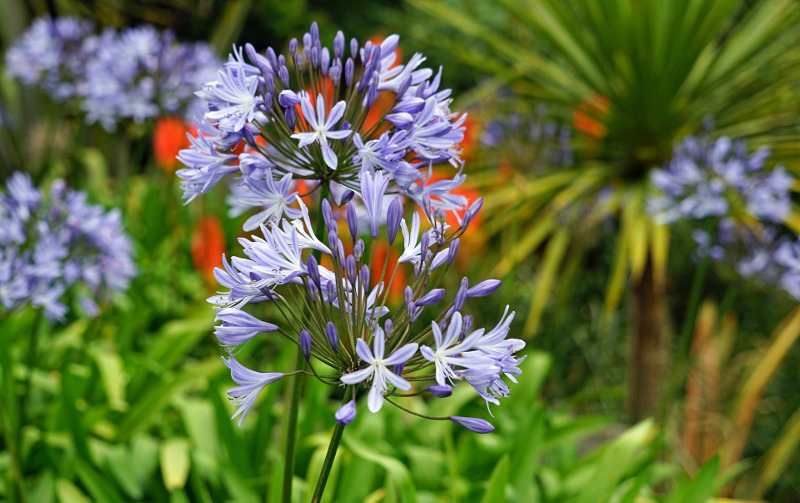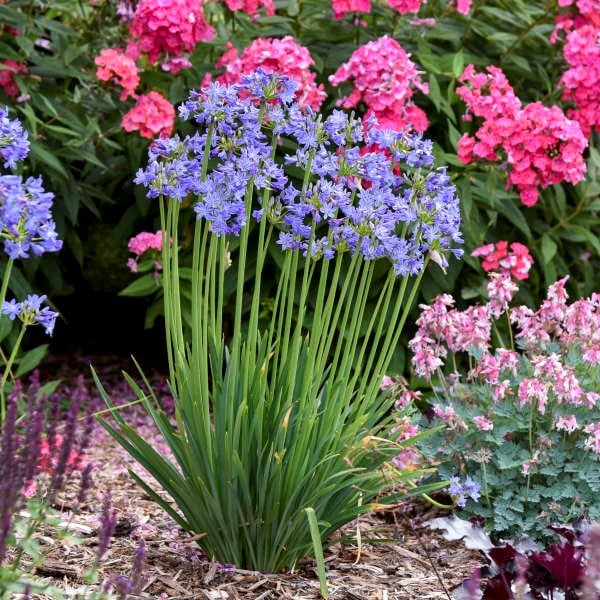Seasonal Agapanthus Treatment: Planning For Wintertime and Summertime
Seasonal Agapanthus Treatment: Planning For Wintertime and Summertime
Blog Article
Grasping the Art of Agapanthus Treatment: Important Actions for Healthy And Balanced Development and Dynamic Flowers
In the world of horticulture, the cultivation of agapanthus stands as a fulfilling undertaking for those that seek to nurture these elegant flowering plants. With their striking blooms and stylish foliage, agapanthus has actually recorded the focus of garden enthusiasts worldwide. Nevertheless, accomplishing optimum development and lively blossoms calls for a nuanced method that incorporates numerous necessary steps. From picking the best variety to mastering trimming techniques, the trip in the direction of cultivating flourishing agapanthus plants is multifaceted and holds the vital to opening the complete capacity of these botanical treasures.

Choosing the Right Agapanthus Range

When selecting the best Agapanthus range for your garden, think about aspects such as environment viability, blossom color, and growth behavior. Agapanthus, frequently called Lily of the Nile or African lily, is available in a variety of colors ranging from tones of purple and blue to white. Choose a flower shade that complements your existing yard scheme to create an unified landscape. Furthermore, consider the climate in your area to make certain the Agapanthus selection you select can thrive in your particular conditions. Some ranges are a lot more tolerant of cold temperature levels, while others favor warmer climates. Understanding the growth practice of different Agapanthus selections is critical for correct positioning within your yard. Some ranges have a clumping development behavior, suitable for containers or boundaries, while others have an even more spreading nature, ideal for ground cover or mass growings. By very carefully reviewing these variables, you can pick the ideal Agapanthus range to improve the appeal of your yard.
Suitable Growing Conditions
Considering the optimum environmental needs is vital for successful Agapanthus farming. Agapanthus grows in well-draining soil with a somewhat acidic to neutral pH level. When planting, choose a location that receives full sunlight to partial shade. In hotter environments, giving some afternoon color can protect against scorching of the fallen leaves. Agapanthus plants are delicate to cold temperature levels and ought to be secured from frost during cold weather.
To make sure healthy and balanced development and vivid blooms, plant Agapanthus light bulbs at a depth of concerning 2-4 inches and space them 8-12 inches apart. Adding raw material, such as compost, to the dirt can boost drainage and fertility, promoting durable origin development. Mulching around the base of the plants assists preserve moisture and suppresses weed development. Normal watering is essential, particularly during the expanding period, to maintain the dirt continually wet yet not waterlogged.
Watering and Feeding Tips
Keeping appropriate moisture degrees and supplying necessary nutrients are essential elements in the treatment program for Agapanthus plants. When it comes to sprinkling Agapanthus, it is critical see post to strike an equilibrium. These plants choose regularly moist soil but are at risk to root rot if overwatered.
Feeding Agapanthus is vital for promoting healthy and balanced growth and respected flowers. Apply a balanced fertilizer, such as a 10-10-10 formula, in the very early spring as brand-new development emerges. Repeat this application every 6-8 weeks throughout the growing period. Prevent extreme fertilization, as it can lead to lush foliage at the expenditure of blossoms. Constantly adhere to the maker's guidelines for proper dilution and application methods. By complying with these watering and feeding pointers, you can guarantee your Agapanthus plants thrive and produce dynamic, resilient blossoms.
Pruning Methods for Agapanthus
Trimming Agapanthus plants at the proper times and with appropriate techniques is vital for maintaining go to my site their health and wellness and promoting optimal development and blooming. The optimal time to trim Agapanthus remains in late winter months or very early spring before brand-new development arises. Begin by eliminating any type of yellowing or dead fallen leaves near the base of the plant. Cut them as short as possible without harming the arising shoots.
Deadheading spent blossoms can additionally reroute the plant's energy into producing more blooms instead than setting seeds. If you want to collect seeds for breeding, leave some visit blossoms to fully grown and completely dry on the plant.
Keep in mind to use clean, sharp tools to make accurate cuts and decrease the threat of presenting conditions. Agapanthus. Routine pruning will help maintain your Agapanthus looking healthy and cool while making sure a bountiful display of attractive blossoms
Handling Usual Parasites and Illness
After making certain proper trimming methods for Agapanthus, it is crucial to deal with common bugs and conditions that can influence the health and wellness and vigor of these plants. One common insect that influences Agapanthus is the Agapanthus gall midget.
Furthermore, Agapanthus plants can suffer from root rot if they are planted in inadequately draining pipes soil. By being watchful and taking prompt activity against bugs and conditions, you can aid your Agapanthus plants grow and generate vivid blossoms. Agapanthus.

Verdict
Finally, understanding the art of agapanthus care includes picking the right selection, offering suitable planting conditions, appropriate watering and feeding, appropriate trimming methods, and dealing with usual bugs and illness. By following these crucial steps, you can ensure healthy and balanced growth and dynamic blossoms for your agapanthus plants. Keep in mind to routinely check and preserve your plants to advertise their general well-being and long life.
To guarantee healthy and balanced growth and vivid flowers, plant Agapanthus bulbs at a depth of about 2-4 inches and area them 8-12 inches apart. By following these watering and fertilizing tips, you can ensure your Agapanthus plants grow and produce vibrant, lasting blossoms.
One typical parasite that affects Agapanthus is the Agapanthus gall midget. Additionally, Agapanthus plants can experience from root rot if they are grown in inadequately draining soil. By complying with these necessary steps, you can make sure healthy growth and lively flowers for your agapanthus plants.
Report this page